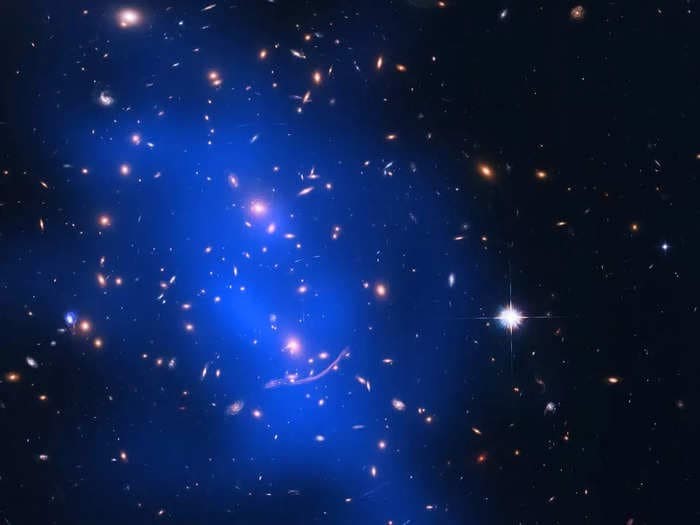Description

Disclaimer: Copyright infringement not intended.
Context
- The discovery of the "Cosmic Vine," an enormous cosmic structure containing around 20 galaxies, is a significant milestone in astronomy and astrophysics.
Details
- The "Cosmic Vine" spans approximately 13 million light-years and contains at least 20 massive galaxies.
- Observed at a redshift of 3.44, indicating its existence when the universe was around 2.5 billion years old.
Unique Characteristics
- Exceptionally lengthy and vast, surpassing the size of other known compact galaxy groups at similar redshifts.
- Contains two of the most massive galaxies ever discovered at such high redshifts (Galaxy A and Galaxy E), both in a quiescent state, implying reduced star formation rates.
Significance
- Offers new perspectives on the formation and evolution of massive galaxies.
- Suggests that massive quiescent galaxies can form within expanding large-scale structures, contrary to some earlier models.
- Implies that the quenching process halting star formation in galaxies can occur in various environments, not solely within galaxy cluster cores.

Repercussions for Galaxy Formation
- Indicates that significant energy releases from supermassive black holes might have subdued Galaxy A and Galaxy E before being integrated into the Cosmic Vine.
- Implies the quenching process can transpire in diverse environments, expanding our understanding beyond galaxy cluster cores.
Future Research and Tools
- Further examination of quiescent cluster galaxies at high redshifts is deemed essential for understanding the formation of such massive structures.
- The Euclid Space Telescope, recently launched and designed to explore the universe's large-scale structures, holds promise in advancing this research.
What are Galaxies?
- Definition: Galaxies are immense systems in space containing stars, stellar remnants, interstellar gas, dust, and dark matter, all held together by gravity.
- Classification:
- Spiral Galaxies: Characterized by spiral arms emanating from a central bulge (e.g., Milky Way).
- Elliptical Galaxies: Generally, elliptical in shape, with stars orbiting randomly (e.g., M87).
- Irregular Galaxies: Lack a defined shape (e.g., Large and Small Magellanic Clouds).
- Lenticular Galaxies: Possess features of both spiral and elliptical galaxies.
Galaxy Formation and Evolution:
- Formation Theories:
- Hierarchical Model: Proposes that galaxies form from smaller structures merging over time.
- Cold Dark Matter (CDM) Model: Suggests that dark matter plays a crucial role in galaxy formation.
- Evolution:
- Star Formation: Galaxies exhibit varying rates of star birth, influenced by gas and dust.
- Galactic Mergers: Larger galaxies can form through collisions and mergers of smaller ones.
- Quenching Processes: Mechanisms that stop or slow down star formation in galaxies.
- Active Galactic Nuclei (AGN):
- Quasars and Blazars: Energetic and luminous centers of galaxies fueled by supermassive black holes.
Galaxy Components:
- Stellar Content:
- Population I and II Stars: Different generations of stars within galaxies, indicating age and metallicity differences.
- Globular Clusters: Dense spherical collections of stars orbiting galaxies.
- Interstellar Medium (ISM):
- Nebulae: Regions of gas and dust where new stars form.
- Molecular Clouds: Dense regions within nebulae that foster star birth.
- Dark Matter:
- Invisible Matter: Detected through gravitational effects, comprising a significant portion of a galaxy's mass.
- Galactic Structures:
- Spiral Arms: Regions of concentrated stars and gas winding around a galaxy's center.
- Central Bulge: Dense area at the core of a galaxy, often housing a supermassive black hole.
Observational Tools and Studies:
- Telescopic Observations:
- Ground-based and space telescopes (Hubble Space Telescope, James Webb Space Telescope) capture images and spectra aiding galaxy studies.
- Redshift and Distance Measurements:
- Use of redshift in spectral lines to determine a galaxy's velocity and distance from Earth.
- Surveys and Catalogs:
- Efforts like the Sloan Digital Sky Survey (SDSS) create comprehensive catalogs of galaxies.
- Cosmological Studies:
- Galaxy surveys assist in understanding large-scale structures and the evolution of the universe.
.jpg)
Conclusion
This discovery challenges previous assumptions about the exclusive formation of massive galaxies within mature galaxy clusters. It emphasizes the need for continued exploration and observation using advanced telescopes like the Euclid Space Telescope to unravel the mysteries surrounding galaxy formation and evolution in the vast cosmos.
|
PRACTICE QUESTION
Q. What theoretical model proposes that galaxies form from smaller structures merging over time?
A) Cold Dark Matter (CDM) Model
B) Hierarchical Model
C) Big Bang Theory
D) Steady State Theory
Answer: B)
|











